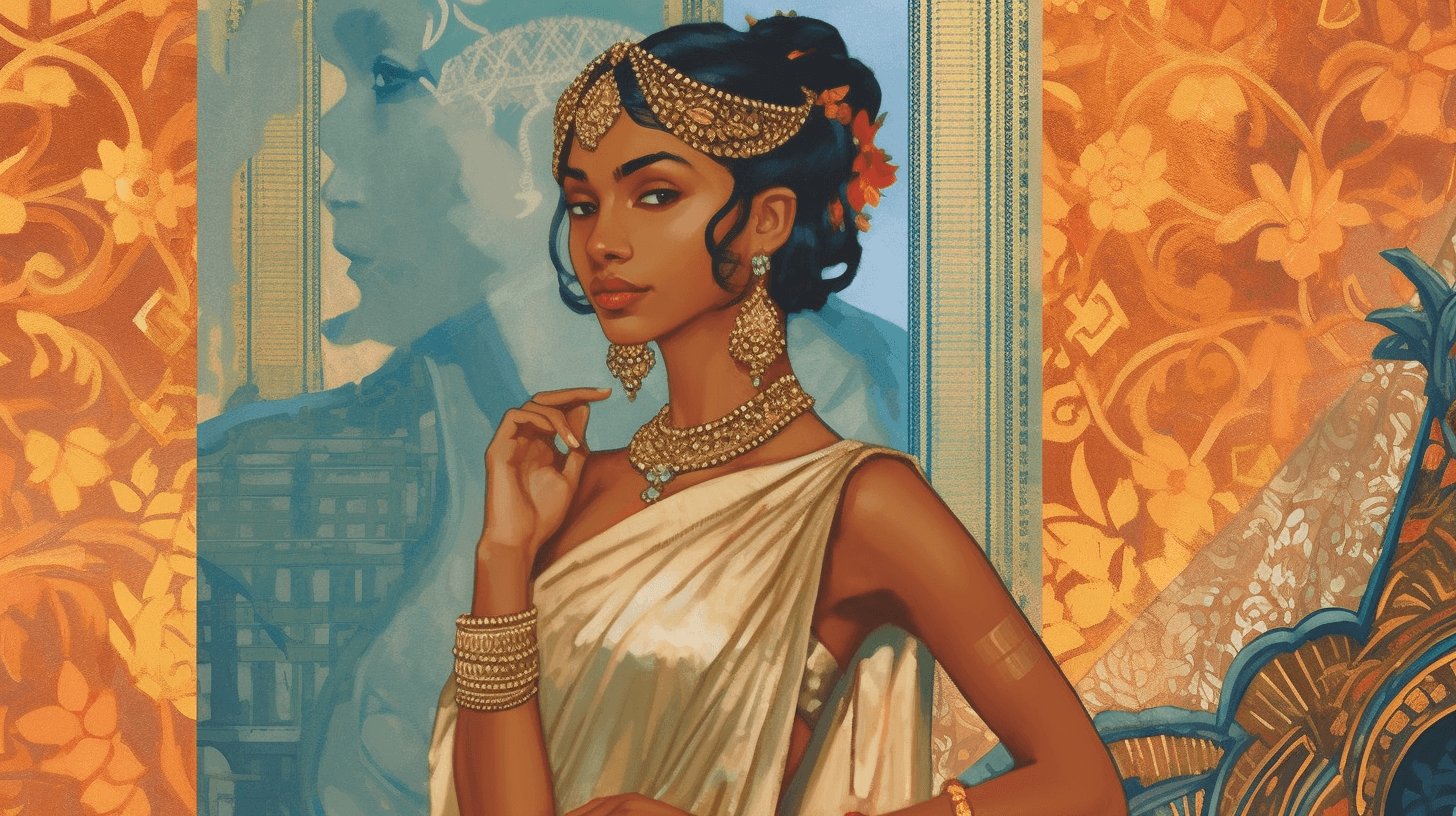💃🌍🎀 Da Sari: Explorin’ its Evolution an’ Influence in da Fashion World
Da sari, one iconic garment worn by South Asian women, stay versatile an’ come in different forms, from mass-produced polyester versions to silk saris woven on hand looms. Dis six- to nine-yard cloth, when draped ’round da body wit’ a blouse an’ petticoat, can create a variety of looks. It has influenced designers like Cristóbal Balenciaga, Gianni Versace, an’ Madame Grès.
Celebrities like Zendaya, Deepika Padukone, an’ Natasha Poonawalla have rocked da sari on red carpets worldwide, bringin’ attention to its beauty an’ cultural significance. An’ now, a new exhibition called “The Offbeat Sari” at da Design Museum in London is spotlightin’ da sari in a whole new light. 🎉🌟
Openin’ on Friday an’ runnin’ through September, dis exhibition explores how da sari is bein’ redefined in contemporary fashion. Priya Khanchandani, da head of curatorial at da museum, says dat da show features both conventional an’ unconventional saris. Some of da standout pieces include a sari embellished wit’ sequins made from discarded X-ray images by Abraham & Thakore, a sculptural sari made wit’ fine steel threads by Rimzim Dadu, an’ a cocoon-shaped nylon sari wit’ a quilted pallu by Huemn. 😍✨👘
Akaaro showcases da use of zari, a fabric wrapped wit’ thin layers of silver or gold, in their sari. Amit Aggarwal’s ruffled sari incorporates boning made from industrial waste, givin’ it a unique coral reef-like look. Da exhibition also highlights da evolution of sari construction an’ stylin’, featurin’ a half sari paired wit’ tailored pants an’ a cape by Anamika Khanna, as well as Tarun Tahiliani’s silvery jersey sari-gown worn by Lady Gaga. Tahiliani is credited wit’ popularizin’ da sari-gown, known for its fixed drapin’ an’ elements like zippers. 💫👗
While some purists argue dat sari-gowns contradict da traditional hand-wrapped styles, which vary across India, “The Offbeat Sari” showcases over 100 regional drapin’ styles in videos, revealin’ da versatility of da garment. Da most common style, Nivi, emerged in da mid-19th century an’ involves wrappin’ da sari ’round da waist an’ across da torso, wit’ da pallu hangin’ over da left shoulder. It’s often paired wit’ a choli, or cropped blouse. 🤳💕
Sumathi Ramaswamy, a history professor at Duke University, explains dat da Nivi style reflects Victorian ideas of modesty an’ respectability durin’ British rule in India. Blouses an’ petticoats became part of da ensemble to conceal a woman’s form. While saris are often reserved fo’ special occasions, many people in India, includin’ members of da Gulabi Gang women’s rights group, wear saris as part of deir daily wardrobe. In fact, “The Offbeat Sari” exhibition includes one sari belongin’ to da group’s founder, Sampat Pal, highlightin’ da garment’s role as a symbol of female activism an’ resistance. 💪💖👩
Ms. Khanchandani points out dat even as India modernizes, da culture remains patriarchal. However, da sari continues to emerge as a countermovement an’ a powerful means of female expression, regardless of da occasion or style. It embodies tradition, identity, an’ creativity, captivatin’ fashion enthusiasts worldwide. 🌺🌍👠
NOW IN ENGLISH
The Sari: Exploring its Evolution and Influence in the Fashion World 💃🌍🎀
The sari, an iconic garment worn by South Asian women, is incredibly versatile and comes in various forms, ranging from mass-produced polyester versions to silk saris woven on hand looms. This six- to nine-yard cloth, when draped around the body with a blouse and petticoat, can create a multitude of stunning looks. It has even left its mark on renowned designers like Cristóbal Balenciaga, Gianni Versace, and Madame Grès.
Celebrities such as Zendaya, Deepika Padukone, and Natasha Poonawalla have graced red carpets worldwide, captivating attention with the beauty and cultural significance of the sari. Now, an exciting exhibition called “The Offbeat Sari” at the Design Museum in London is shedding new light on this timeless garment. 🎉🌟
Running from Friday through September, this exhibition delves into the redefinition of the sari in contemporary fashion. Priya Khanchandani, the head curator at the museum, reveals that the show features both traditional and unconventional saris. Some notable pieces include a sari adorned with sequins made from discarded X-ray images by Abraham & Thakore, a sculptural sari crafted with fine steel threads by Rimzim Dadu, and a unique cocoon-shaped nylon sari with a quilted pallu by Huemn. 😍✨👘
Akaaro showcases the use of zari, a fabric wrapped with thin layers of silver or gold, in their saris. Amit Aggarwal’s ruffled sari incorporates boning made from industrial waste, creating a distinctive coral reef-like appearance. The exhibition also highlights the evolution of sari construction and styling, featuring a half sari paired with tailored pants and a cape by Anamika Khanna, as well as Tarun Tahiliani’s silvery jersey sari-gown famously worn by Lady Gaga. Tahiliani is credited with popularizing the sari-gown, renowned for its fixed draping and elements like zippers. 💫👗
While some purists argue that sari-gowns contradict the traditional hand-wrapped styles that vary across India, “The Offbeat Sari” exhibition showcases over 100 regional draping styles in videos, revealing the incredible versatility of this garment. Among these styles, the most common is the Nivi, which emerged in the mid-19th century. It involves wrapping the sari around the waist and across the torso, with the pallu gracefully hanging over the left shoulder. Often, it is paired with a choli, a cropped blouse. 🤳💕
Sumathi Ramaswamy, a history professor at Duke University, explains that the Nivi style reflects Victorian ideas of modesty and respectability during British rule in India. Blouses and petticoats became integral parts of the ensemble to conceal a woman’s form. While saris are often reserved for special occasions, many people in India, including members of the Gulabi Gang women’s rights group, proudly incorporate saris into their daily wardrobes. In fact, “The Offbeat Sari” exhibition even includes a sari belonging to the group’s founder, Sampat Pal, highlighting the garment’s role as a symbol of female activism and resistance. 💪💖👩
Ms. Khanchandani emphasizes that despite India’s modernization, its culture remains patriarchal. Nevertheless, the sari continues to emerge as a powerful means of female expression and a counter-movement, transcending boundaries of occasion and style. It encapsulates tradition, identity, and creativity, captivating fashion enthusiasts worldwide. 🌺🌍







